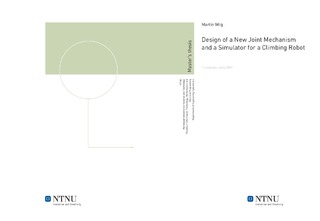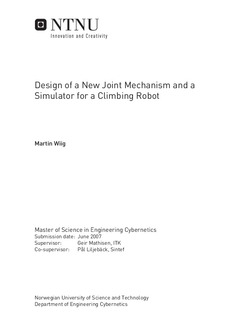| dc.description.abstract | This report covers the development of a new joint mechanism and a robotic simulator. These are intended to be used in the further development of a climbing robot that has been previously worked on. The climbing robot is briefly described in this report. It is a robot with four arms that each has 6 joints with 1 degree of freedom each. At the end of each arm is a gripper that will serve as the robots main tool of interaction with its immediate environment, for instance a ladder the robot is climbing in. The weight of this robot is estimated and used to find torque requirements on the new joint mechanism. A lightweight joint mechanism is of interest not only for a climbing robot, but for many if not all other kinds of robots as well. Such a joint will not need to be as strong as its heavier counterparts, as less power is required to support the joint itself. The new joint mechanism is an attempt of creating a joint that is lighter than traditional joints. The main idea is to have a single powerful actuator driving several joints. The joints are mechanically powered by a rotating shaft that runs through all of them. Each joint uses a clutching mechanism to connect to the shaft and thus transfer torque. the clutching mechanism has been explored in detail, and a suitable clutch has been selected. This clutch is then used in four design proposals. The last of these proposals is assembled into a prototype, and the prototype is qualitatively tested. The tests demonstrate the concept, but it is not yet shown that this joint mechanism will be lighter that a traditional joint mechanism. The simulator is developed to be a design tool for further development of the climbing robot. A list of specifications for the simulator is presented, however the simulator is not able to meet all these requirements at the current stage of development. The remaining work on the simulator is discussed, as well as an evaluation of the software as it is at the time of writing. The report describes the kinematic modeling that is used to represent the translational and rotational relationship between the different elements of the robot. The kinematic relationships is then put into a mathematical representation of the robot which represents the robots as a chain of elements. Each element has several properties, among which are its relationship to other elements and a graphical representation of the element. The elements, and thus the robot, is represented graphically in a virtual reality environment. The simulator allows the user to specify several parameters of the robot, such as number and dimensions of the joints and the dimensions of the body. The user is also able to control the velocity of each joint. Both the simulator and the joint has been developed to be general enough for use on other kinds of robots, with small modifications in the case of the simulator. | nb_NO |

